Archived Mold Remediation Blog Posts
Places Mold Can Hide
7/28/2020 (Permalink)
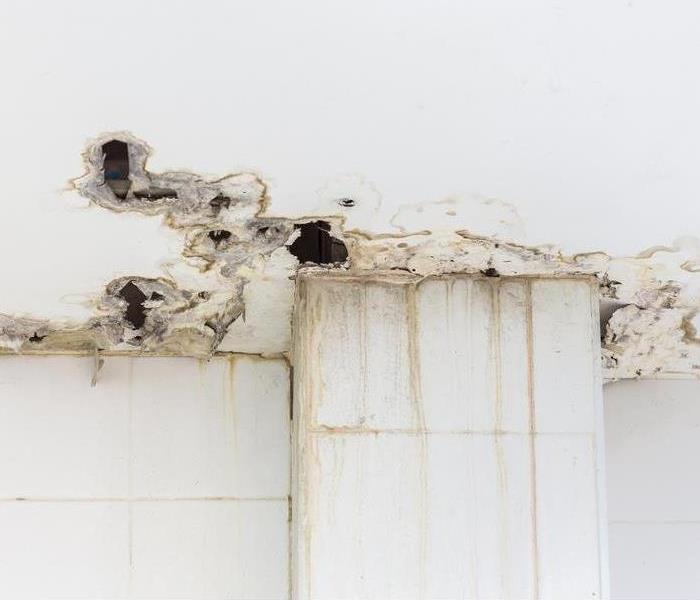 Hidden mold growth might seem like an impossible problem.
Hidden mold growth might seem like an impossible problem.
When your Edmond, OK, has mold growth, there is an undeniably musty odor that can’t be overlooked. While the smell is very noticeable, the source of it isn’t always so easy to decipher. If you have had recent flooding, it can be easy to determine there could be mold on wood or other organic materials. If there hasn’t been any noticeable water damage, there is moisture lurking somewhere in your home.
Top Hiding Spots
Mold is a tricky fungus that loves warm weather, moisture, and food, which happens to be about any organic material found in the home. Along with moldy drywall or other structural components hidden behind the walls, there are a number of surprising places where mold could be growing. If you can’t easily find the source, check the following areas:
Window sills
Carpet and carpet pads
Refrigerator or HVAC drip pans
Wallpaper
Attics and crawlspaces
Washing machines
Chimneys
Air ducts
Water heaters
Ceiling tiles
Houseplants
Professional Help
Even a little mold growth can turn into a big problem. Unlike mildew, which sits on the surface, mold penetrates below a surface. If mold is hiding in your home, it can slowly be rotting integral components and precious belongings. If it continues to go unchecked, it can be much more difficult to clean up.
At the first signs of that musty odor, inspect your home. If you are unable to locate the trouble area, or you find it and it is more than you expected, immediately call mold remediation and restoration expert. Along with having the latest tools and expertise to clean up the mold, they also have certified technicians trained in finding hidden water sources. Once the mold is discovered, they use containment procedures to keep it from spreading during the remediation process.
Hidden mold growth might seem like an impossible problem. Knowing where to look and getting the right help can make it “Like it never even happened.”
What To Know About How Mold Grows and Spreads
9/26/2019 (Permalink)
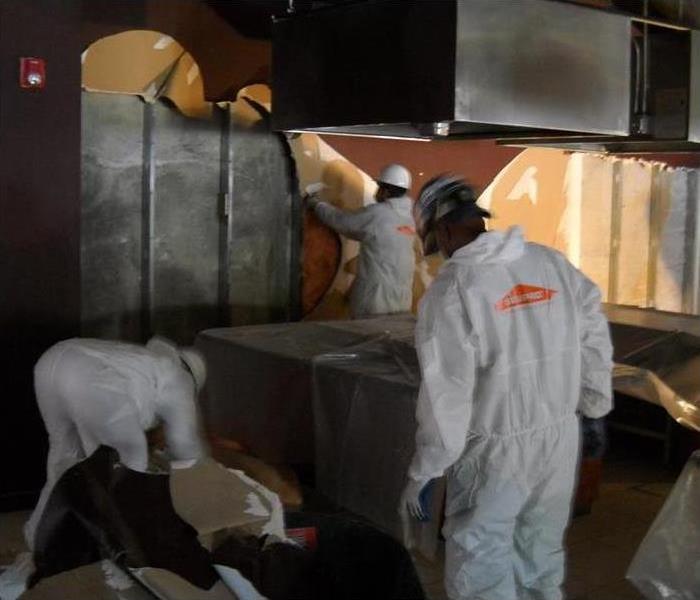 Mold remediation in a Hibsaw, OK home
Mold remediation in a Hibsaw, OK home
Three Things You Should Know About Fungus
One of the most important things to understand about mold mitigation in Hibsaw, OK, is how to avoid spreading mold during the cleaning process. As such, it's important to understand what mold is and how it grows. Here are three things you should know.
1. Mold is a Fungi
It's important to know that all molds, including black mold, fall into the fungi family. This means that they feed off of organic materials such as wood or paper, and reproduce via spores. On its own mold cannot be seen by the naked eye. However, what is seen and commonly associated as mold is actually colonies of multiple spores growing together. They can vary in appearance from flat and slightly fuzzy to more downey. Colors range through white, brown, gray, green, and even black.
2. Spores Can Be Airborne
It's also important to note that any spreading mold could be caused by airborne spores. This is one reason why it's important to quarantine the area when it's being cleaned. Your mold remediation professional will have the tools and knowledge needed to test for, and thoroughly clean, any places where mold may be growing in your home.
3. It Must Be Treated at the Source
One important thing to know about mold remediation is that any mold found must be treated at the source in order to completely remove the problem. This is why it's always best to contact professional when mold is located in the home. Not only will they know the most likely locations to seek out mold, but they have several tests they can perform in order to confirm its presence.
Avoiding spreading mold during the remediation process is an important step to removing mold from the home. Understanding that it is a fungi which spreads through airborne spores can help you know how to quarantine the affected area while the cleaning process is carried out. If you have any questions a professional may be able to help.
How To Tell If Your Building Is Contaminated With Mold
7/30/2019 (Permalink)
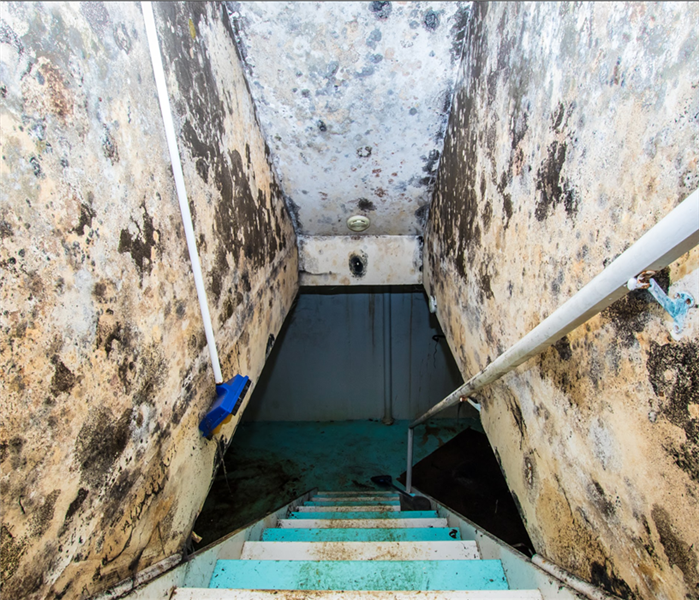 Basement with mold damage
Basement with mold damage
Common Places Mold Growth Occurs
Just because you cannot see mold does not mean it's not there. Mold often lurks in the dark recesses of buildings and in places where humans either don't or cannot frequent. Some of the more common places mold growth occurs include the following:
- Air ducts
- Basements and attics
- Window sills and sashes
- Air conditioning units
- Beneath sinks
- Tile grout
- Carpet
If you suspect your building has mold but a visual inspection yields no evidence of it, contact an indoor environmental specialist in Arcadia, OK. The said specialist can take samples and perform a mold test to determine the extent of the damage.
Other Signs Your Building is Contaminated With
Mold
Chances are, there's a reason you suspect your building is hiding a mold infestation. Mold puts off a musty odor that many compare to that of a wet dog or a wet towel. If your building smells musty, there's a good possibility mold lurks beneath the walls.
Because mold feeds off surrounding materials, you may begin to notice that your drywall sags or that your ceilings seem frail and on the point of collapse. If you notice either of those symptoms, the infestation is likely extensive. Again, and indoor environmental specialist can tell you just how extensive the issue is.
If you discover a leaking pipe or signs of water damage, you should prepare for the discovery of mold growth. Mold almost always develops where there is an untreated water issue. Likewise, if your building was recently in a flood or fire, you should contact a professional to perform an inspection, just in case.
What To Do If Test Results Reveal Mold
If the mold test reveals that your building does, in fact, have mold, don't panic. A professional mold remediation specialist can use the findings from the indoor environmental specialist and devise a plan for quickly and effectively removing the fungus.
What Is Causing the Mold in Your Commercial Building?
2/20/2019 (Permalink)
 Leaky faucets can cause mold growth
Leaky faucets can cause mold growth
What is a Moisture Problem?
If you found black mold, or any type of fungus, growing in your commercial building in Edmond, OK, you are likely wondering how it got there. Was it a moisture problem? Has it been there for a long time? Knowing what caused the growth may help you avoid the need for more mold cleanup in the future.
Stagnant Air
Air flow can actually help discourage mold buildup because it may dry out the area mold has chosen to make its home. If you have to turn off the HVAC unit for your building, you may be encouraging the growth of fungus. Try to keep some type of airflow going even when you do not plan on running your heating or air conditioning unit.
Moisture
Fungus needs moisture to survive. This dampness can come from a lot of sources, including:
- Burst pipes
- Leaky faucets
- Broken supply lines
- Flooding
Even something as simple as high humidity in a building can cause the growth of mold. If your facility has 70 percent humidity, you may want to find a way to reduce the moisture in the air.
High Temperatures
Warmth is another element black mold and many other fungus variations love. Sometimes the temperatures in empty warehouses or busy factories can get quite high. Whenever possible, you should try to keep your buildings below the mid-70s on the Fahrenheit scale to discourage the growth of fungus.
Darkness
Another environmental element that could lead to more appearances of mold is darkness. Darkness alone might not be enough to cause mold growth, but it is often associated with damp, stagnant places. The environment of your commercial building can play a big role in the development of fungi.
As you get ready to initiate mold cleanup with the help of a commercial remediation team, it can be helpful to know what caused the appearance of black mold. Fixing a moisture problem, for example, could stop the recurrence of this fungus.
For more information, visit http://www.SERVPROedmond.com.
Black Mold Is Like the Annoying Visitor Who Never Leaves
1/21/2019 (Permalink)
 Black mold can be very dangerous for your health
Black mold can be very dangerous for your health
Facts About Black Mold
The term black mold strikes fear into the hearts of homeowners everywhere. Few know anything about it. Here are some facts that you should know about this fungus:
- Stachybotrys is its technical name
- Stachybotrys is not always black
- Not all black-colored molds are Stachybotrys
- You don’t want it in your home
Perhaps you already have mold. You didn’t intentionally invite it to visit. You didn’t ask it to stay. It won’t leave anytime soon. It’s a nuisance. It’s unattractive. It’s destructive. It’s a threat. It won’t die. It needs to go. It’s not leaving voluntarily.
Mold Is Relentless
If you go on vacation and your houseplants don’t get watered, they are dead when you return home. No amount of water is going to revive them.
If you remove the source of moisture from black mold, it becomes dormant. When the moisture returns, it comes back to life as if nothing happened.
Start by Finding All the Mold
You found the mold in your home and called in experts to help with the remediation. However, it is important to locate all the mold colonies before the cleanup begins. A conventional technique for finding them involves taking air samples throughout the home. Samples with the highest concentration of mold identify locations close to active colonies.
Mold Cleanup Requires More Than Eliminating the
Moisture Problem
The secret to getting rid of mold is to destroy it without releasing any into the air. There are many techniques for doing this. They all require the cleaner to wear a mask and other protective equipment. Some of these techniques are:
- Abrasive blasting with baking soda or dry ice
- Treating with chemicals that kill the mold
- Vacuuming with HEPA filters
Don’t allow the situation to get worse. Call on a team of mold remediation specialists in the Edmond, OK, area to solve your black mold problem. They are only a phone call away.
Why Mold Grows on Food
9/9/2018 (Permalink)
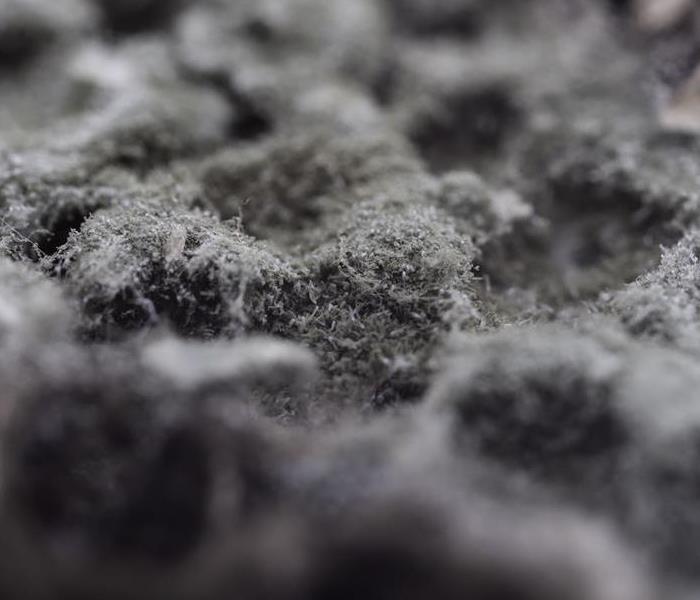 Mold’s insatiable appetite can extend well beyond the kitchen.
Mold’s insatiable appetite can extend well beyond the kitchen.
Residents of Edmond, OK, are surely no strangers to the unwelcome phenomenon of bread mold, and that is because its spores proliferate in the environment. It is a fungus that does not need sunlight to quickly colonize a tasty loaf of whole wheat, rye or pumpernickel.
Bread: Mold’s Staff of Life
A remarkable opportunist, mold’s needs are simple. Moisture is vital to its existence. It grows more quickly in warm surroundings but can also present itself as fridge mold.
• Fresh loaves are often kept in a sealed bag that impedes air circulation and holds in moisture, and this assists the formation of bread mold.
• The darkness of a bread box or refrigerator provides a nurturing environment for mold.
• The starch in bread breaks down into sugars that provide high energy for fungus growth.
Avoiding Moldy Food
The speed at which mold can grow on foodstuffs can be surprising. Thousands of spores can grow within hours, and millions within days. Foods high in sugar including sauces, fruits, jams and jellies, cheeses and other dairy items are susceptible to mold growth.
To avoid the waste of food lost to mold, vigilance is needed. Take note of when packaged food is opened and partially used and try to finish it or freeze it for later use. Food containing preservatives will have longer shelf life, but it is important to avoid tucking it into the refrigerator door or pushing it to the back where it can be forgotten. Keep an eye on fresh fruits and eat them, cook them or freeze them as soon as possible. Starchy baked goods can also be frozen until needed.
Mold’s insatiable appetite can extend well beyond the kitchen. If a home experiences water infiltration or humidity over 45%, a problem more serious than bread mold can develop. Fortunately, mold remediation specialists are just a phone call away. And a fresh loaf of bread is as close as a trip to the grocery. For more information, visit http://www.SERVPROedmond.com/.
Can I Just Wait for Mold to Die?
5/22/2018 (Permalink)
 Mold cleanup isn’t enough if you don’t address that you likely have a moisture problem.
Mold cleanup isn’t enough if you don’t address that you likely have a moisture problem.
Because mold is a living organism like any other, you may hope that if you wait long enough the mold will die off on its own and leave you mold-free with a clean, un-infested home. Yet mold, particularly black mold, is far more pernicious than you think, and if you want to rid your Edmond, OK, home of mold you need to understand why the waiting game is one you’ll always lose.
Mold Is Everywhere
Just because you can’t see mold doesn’t mean it’s not there. Even if you don’t have mold growing on single surface in your home, the air is still riddled with spores just looking for the right conditions to take root. Yet it’s likely that if you had a mold problem once, you’ll have it again, and even once your home is dry you’ll still find mold cropping up in places like:
• Dark, damp corners in bathrooms, storage rooms, and basements
• Drywall and the interiors of walls
• Underneath linoleum and vinyl flooring
• In wooden flooring, doorframes, and window frames
• In your furniture and curtains
• In and behind wallpaper
Even if it’s not prominent, you may still have mold hidden somewhere within your home. Watch for signs of black mold, including creeping, fuzzy growths.
You Won’t Fix Your Problem if You Don’t Address the Source
Mold cleanup isn’t enough if you don’t address that you likely have a moisture problem. Moisture is the root of all issues with black mold, whether it’s from flooding, from an overly humid environment, or from leaky roofs, windows, and appliances. Hiring a mold remediation specialist may help you track down the source of your moisture issue, and take steps to eliminate it and fully dry out your house. Mold remediation is primarily about prevention. Remove the conditions in which mold thrives, and remove the threat of another mold outbreak from your home. For more information, visit http://www.SERVPROedmond.com/.
There Is Nothing Like a Dam: How Ice Dams Lead to Mold Damage
4/24/2018 (Permalink)
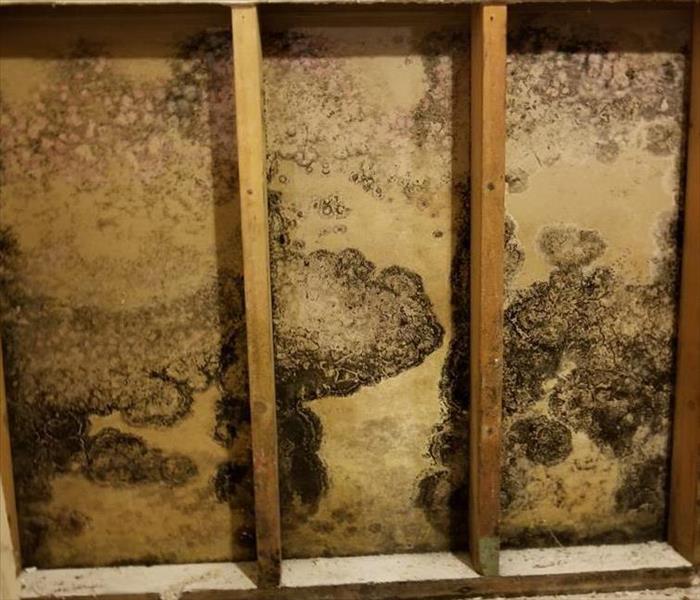 The formation of icicles means you have an ice dam, which can lead directly to black mold growth.
The formation of icicles means you have an ice dam, which can lead directly to black mold growth.
Looking at the buildings and shopfronts around downtown Edmond, OK, this winter, you may notice that many have icicles hanging from the roof. While icicles are prized by Christmas card artists for their aesthetic beauty, icicles can mean trouble for a business owner. The formation of icicles means you have an ice dam, which can lead directly to black mold growth.
How Do Ice Dams Form?
1. When heat escapes from the attic or top floor of a building, it raises the temperature of the roof, melting the snow.
2. The melted snow runs down the roof and refreezes at the edge. The shelf of ice that forms is called an ice dam.
3. These ice dams block the gutters, preventing water from draining properly off the roof.
How Do Ice Dams Lead to Mold Damage?
When ice dams block the gutters, water cannot drain and off the roof the way it's supposed to. However, the water still has to go somewhere, and often that means seeping under the roofing and into the walls.
Once you have water in the walls, there's potential for mold growth. Mold needs moisture and food in order to grow, and it feeds on common building materials. Once water seeps into the building, black mold can start growing in as little as a day.
How Can You Prevent Ice Dams and Water Leaks?
Preventing the problem now can save costly mold cleanup later. Fortunately, there are a few simple steps you can take to prevent ice dams and water leaks.
• Insulate the building's upper level. Ice dams form when the upper level of a building is not properly insulated, allowing heat to escape.
• Keep the gutters clean. Gutters that are free of debris are less likely to form an ice dam.
• Be aware of the signs of water leaks in the building, such as discolored spots on the ceiling or a musty smell, and be prepared to take action.
If you suspect you have water seepage or black mold, don't wait. Contact a reputable water/mold cleanup company in Edmond, OK, immediately. For more information, visit http://www.SERVPROedmond.com//
Detecting and Treating Plant Mildew
3/27/2018 (Permalink)
Mildew is a fungus found only on living plants. Because it’s a parasite, it can quickly spread and completely destroy the infected plant and others in the vicinity. Damp climates can assist in causing plant mildew in Edmond, OK. If there isn’t proper air circulation and the environment is especially humid, this fungus can show up and begin to take over your plants.
There are two types of mildew, and they are distinguished in two ways. The first is a powder-like matter that can be seen on the top and bottom of the leaves. The second is a velvety substance and will grow only on the bottom of the leaves. Of the two, the latter can actually be spread by watering.
Important Tips To Get Rid of Plant Mildew
The discovery of mildew on plants requires immediate action. Here are some ways to treat your plants and stop the fungus from spreading:
• Any leaves that are infected must be clipped and thrown away
• Ensure proper air circulation around the plant and don’t group plants too closely together
• Keep the room that the plants are in dry, not humid
• Water at the roots only
• Use a fungicide to treat the mildew growth
Things To Look for When Checking for Mildew
Your plants will show you in color if they are suffering from mildew. Look for discolored leaves, typically a yellowish color. Sometimes they will begin to look gray and faded. The obvious sign will be the appearance of the mildew itself, which may take on a range of different colors, such as yellow or purple. Once detected, take immediate action to save your infected plant and any others in your home.
Keeping your home free of excess humidity and checking your plants regularly are great preventative steps to protecting your plants. If you discover plant mildew, quick action on your part may save them. If you believe your home may be experiencing high air moisture content, you can always consult a professional company that deals with issues such as mildew for guidance. Visit http://www.SERVPROedmond.com for more information on mold.
Is your home covered in mold?
2/18/2018 (Permalink)
One of the most devastating experiences one can have in their home is growing behind your drywall.
It only takes just a small water leak, or excess humidity in the home to create the perfect condition for mold to develop. It is a form of fungus, and the mold spores can spread to extensive areas in short period. They mostly develop in moist areas such as the bathrooms, under the sinks and in dark environments that are moist.
The damages that come with it are numerous and costly. They affect the house in a way that is damaging to the property. The mold spores damage the carpet, flooring, ducts, walls, and other surfaces the fungus can grow. If not contained, the damages will be seen in other places of the home.
Remediation is the key to mold growth. Call the experts of SERVPRO of Edmond to clean your mold damaged home.
How do I test for mold?
2/18/2018 (Permalink)
The proper way to test for mold is through an hygienist.
If you notice that your home has developed this microbial growth, a proper mold test should be done by a qualified environmental hygienist. The right mold test is important in figuring out the right treatment for the fungus since not all microbial growth is mold. It could be viruses or even bacteria.
Getting a professional hygienist to do the job is important since they will be able to cover all the angles with their advanced methods. Part of their testing includes taking air samples to determine the concentration of spores and a lab test to determine even the minute details that may not be visible to a naked eye. After a detailed and professional testing and analysis, they will be able to determine the most suitable mode of treatment.
Visit http://www.SERVPROedmond.com for more information on mold damage.
Should I make a mold claim?
2/18/2018 (Permalink)
Does your insurance cover mold?
The importance of a qualified and certified environmental hygienist cannot be emphasized any further. There are several hygienist operating in the Edmond area. However, sometimes the infection can be detected at an early stage. If this is the case for one’s home, then the remediation can cost much less One should be careful to be efficient to avoid missing a spot. Also, they could seek the advice and guidance of a professional to ensure they are effective and that they administer the right treatment.
If one’s home has an insurance plan with their insurance company that covers mold-treatment, then they should claim it. An insurance policy can be very helpful in handling such a case since one will not have to bear the restoration costs.
Visit http://www.SERVPROedmond.com for more information on mold damage.
What should I do if I find mold?
2/18/2018 (Permalink)
Prevent Further Contamination
The next step after finding mold is to ensure that preventive measures are taken. This means that the causes that led to the infection are corrected to prevent future damage. One should ensure that their plumbing system in functioning well. There should not be any leaks. Also, one should ensure that their home is well-ventilated for proper air circulation. Use the air conditioning units to control the temperature and the moisture levels in the home.
Do not wait until the infection is widely spread and the home damaged. Once one suspects an infection in their home, they should get the relevant professionals to contain the situation as soon as possible. Otherwise, the damage may be too much.
Visit http://www.SERVPROedmond.com for more information on mold damage.



 24/7 Emergency Service
24/7 Emergency Service





